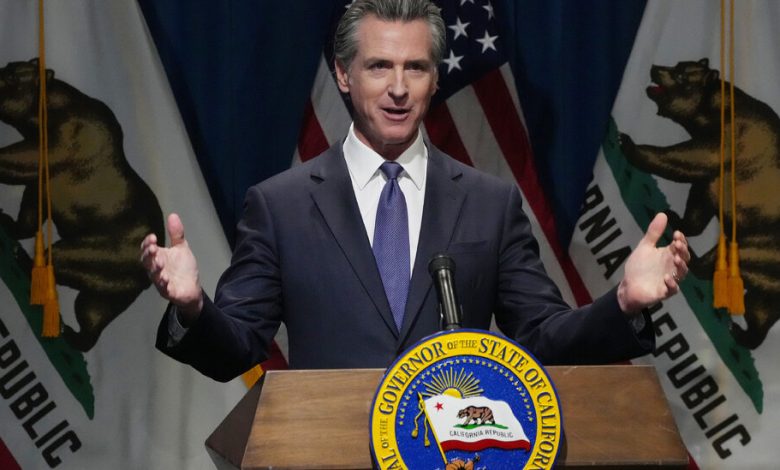Newsom Seeks to Close $37.9 Billion Deficit by Cutting Spending and Using Reserves

The News
Gov. Gavin Newsom announced on Wednesday that California had a $37.9 billion budget deficit and asked state lawmakers to cover the shortfall by trimming spending and drawing down reserves in an election year.

California Gov. Gavin Newsom discussed his state budget proposal in Sacramento on Wednesday.Credit…Jim Wilson/The New York Times
The Numbers
Mr. Newsom said his finance department, working with updated revenue figures, had determined that lawmakers would have to offset a deficit of $37.9 billion for the fiscal year that starts on July 1, which is substantially lower than the $68 billion deficit that the state’s nonpartisan budget analyst had projected.
To accomplish that, the governor proposed covering nearly $19 billion of the gap with reserves, trimming nearly $12 billion from planned spending and delaying a little more than $7 billion in spending commitments into the next fiscal year.
Why It Matters
California has the nation’s largest population, with 39 million residents, and its budget decisions affect almost every aspect of life in the state, including public schools, highways and the social safety net.
The state’s Democratic leaders are regularly judged by their spending choices, not just by voters in California, and Mr. Newsom has positioned himself ahead of the 2024 presidential election as a defender of Democratic values.
For most of Mr. Newsom’s tenure, California has spent heavily on social programs while amassing an enviable budget surplus. But revenue collections in the state are subject to wide swings because California relies heavily on taxing capital gains, property and the personal income of high earners.
Revenues fell behind last year because high interest rates had slowed growth in key economic sectors, deterring home sales and investment in startups and raising borrowing costs for businesses. California also had the unusual challenge of approving a budget in June without a clear revenue picture because taxpayers were allowed to delay their filings until late fall.
California is not the only state tightening its belt in the post-pandemic economy. Arizona lawmakers are grappling with a shortfall in part because of an ambitious tax cut, Maryland lawmakers are working to cover the loss of federal pandemic funding, and slowing economic growth has left New York legislators to confront a $4.3 billion budget deficit.
What Happens Next
In California, the governor’s spending proposal of $291.5 billion will go to the Legislature, which is dominated by his party. Mr. Newsom has asked that lawmakers maintain most of the priorities that he has advanced since his 2018 election, including an ambitious Medicaid expansion that extends health insurance to all low-income adults regardless of their immigration status.
Modest proposed cuts would focus mainly on climate and housing programs. The governor also indicated that he would like to delay a planned increase in the minimum wage for health care workers to $25 an hour if revenues fall below a certain threshold.
Nationally, California’s finances are already political grist and will very likely remain so. On Wednesday, Mr. Newsom digressed from his budget presentation to denounce the editorial board of The Wall Street Journal for implying that he might consider covering the state’s budget gap with a wealth tax.
The governor on Wednesday rejected the idea outright, as he has repeatedly before. He then called the editorial board “a broken clock” and part of a “shameful” false narrative that Republicans have put forward “over and over and over again” to damage his state.




